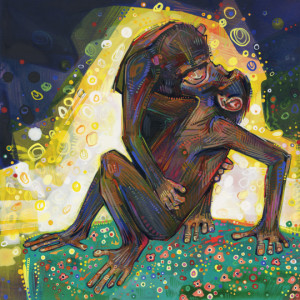Bonobos in THE QUALMS by Bruce Norris
Bonobos are first mentioned more than halfway through THE QUALMS. Party host Gary says that humans are genetically engineered for warfare. His partner Teri says, “That’s not true. What about bonobos?” Gary continues, “—look at chimpanzees. Chimps conduct strategic attacks on rival tribes.” After the others protest, he adds, “—to protect their territory.” Then Teri says, “But Gary, Bonobos resolve conflict through sex instead of aggression and we’re genetically closer to bonobos.”
This déjà vu bonobo lesson got my attention. It was so similar to the bonobo and chimp parable in David Grieg’s THE EVENTS. [Bonobo Part 1: THE EVENTS] In this instance, however, there was cause to believe Bruce Norris would go further. And he does. His subject in THE QUALMS (Playwrights Horizons May 2015—July 2015) is closer to what has so intrigued us about bonobos, their use of sex to resolve conflict.
The play’s setting is a beach community condo owned by Gary and Teri where four couples have gathered, in theory, for erotic partner swapping. Newcomers Chris and Kristy struggle to fit into the “lifestyle.” Chris, in particular, can’t get past his hierarchal orientation.
His insistence on class distinction is cleverly symbolized by his bringing an expensive bottle of cabernet to the party. Inevitably the red wine and associations with spilt red wine contribute to the crisis.
BONOBO AND CHIMP ZOO CHATTER
Bruce Norris is the author of a dozen or so unsettling, naturalistic comedies, including the Pulitzer Prize winning Claiborne Park. Many like THE QUALMS originated with Steppenwolf Theatre Company.
In his introduction (Playwrights Horizons Preview Editions), the playwright undersells THE QUALMS with a dry sociological account of the play exploring class competiveness. Sure, there’s that, but without question the eight characters interact as archetypal party animals. The audience is encouraged to view the beach condo scenario as a human zoo exhibition.
There is a frequent wonderful effect of five or six of the characters talking at the same time. In print these chatterings are formatted in short columns across the page. Each chattering marks a significant juncture in the group dynamic with a cascade of character views that advance the insecurity and tension.


Recent Comments